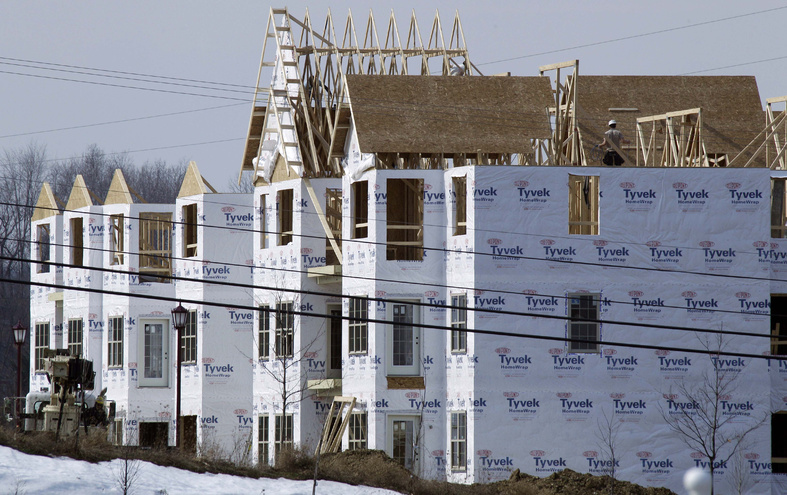WASHINGTON – Sales of new homes plummeted in January, and businesses ordered fewer long-lasting goods. But the number of people applying for unemployment benefits has fallen over the past four weeks to the lowest level in 2½ years.
Together, the government reports Thursday sketched a mixed picture. They suggest that the struggling housing industry remains a drag on an economy that’s growing slowly but steadily.
The reports showed:
• New-home sales dropped 12.6 percent in January from the previous month, to a seasonally adjusted annual rate of 284,000, the Commerce Department said. That’s less than half the pace that economists consider healthy. The drop is a worrisome sign because it follows the worst year for new-home sales in nearly 50 years.
• In Maine, sales of existing homes rose 11 percent in January compared with a year ago, while the median sale price remained flat. The Maine Association of Realtors said real estate agents sold 536 single-family homes during the month, up from 484 in January 2010. The median sale price for those homes was $160,000.
For the three-month period from November through January, statewide home sales were down 12 percent compared with the same period a year earlier. At the same time, the median sale price for those Maine homes rose about 2 percent.
• Nationally, company orders for long-lasting manufactured goods, excluding the volatile aircraft and auto categories, fell 3.6 percent last month, Commerce said in a separate report. The drop followed two months of gains. One category that’s viewed as a proxy for business investment spending fell by the largest amount in two years.
Overall, orders for durable goods rose 2.7 percent, driven by a jump in commercial aircraft orders. Still, orders totaled around $200 billion. That’s considered a healthy level, and it’s 25 percent above the recession low hit in March 2009.
• Applications for unemployment benefits dropped by 22,000 last week to a seasonally adjusted 391,000, the Labor Department said. It was the third decline in four weeks.
The four-week average for applications, a less volatile figure, fell to 402,000. It was the fewest since late July 2008 and a sign the job market is slowly improving.
Layoffs have fallen to pre-recession lows. And the downward trend in applications for unemployment benefits indicates they are dropping further. Still, employers aren’t hiring enough to lower high unemployment.
Applications for unemployment benefits below 425,000 tend to signal modest job creation. But they would need to dip consistently to 375,000 or below to indicate a significant drop in the unemployment rate. Applications for benefits peaked during the recession at 651,000.
“While layoffs have come way down, new hiring hasn’t picked up appreciably,” said Cary Leahey, an economist at Decision Economics. “Many firms are still sitting on the fence.”
That reluctance could continue for a few months, Leahey cautioned, becasue of the turmoil in the Middle East. That’s pushing up oil and gas prices, which could leave consumers with less money to spend. Businesses might hold off on hiring for a few more months until the uncertainty clears.
The economy is growing, but not fast enough to encourage aggressive hiring.
The nation’s gross domestic product, the broadest gauge of the output of goods and services, rose at a 3.2 percent annual rate in the October-December quarter. The government will update its fourth-quarter estimate Friday; economists think the figure will be revised up slightly to 3.3 percent.
One of the clouds hanging over the economy is the depressed housing market, which many analysts say hasn’t yet bottomed out. Last year marked the fifth straight annual decline for new-home sales after they hit record highs during the housing boom.
Buyers purchased 322,000 new homes last year. It was the fewest annual total on records going back 47 years. Economists say it could take years before sales return to a healthy pace.
Builders of new homes are struggling to compete in markets saturated with foreclosures. High unemployment and uncertainty over home prices have kept many potential buyers away.
Poor sales of new homes mean fewer jobs in the construction industry, which normally powers economic recoveries. On average, each new home built creates the equivalent of three jobs for a year and generates about $90,000 in taxes, according to the National Association of Home Builders.
The broader housing sector hasn’t fared much better. Sales of previously occupied homes rose slightly last month. But the seasonally adjusted annual pace of 5.36 million is far below the 6 million homes a year needed to maintain a healthy market.
Copy the Story Link
Send questions/comments to the editors.



Success. Please wait for the page to reload. If the page does not reload within 5 seconds, please refresh the page.
Enter your email and password to access comments.
Hi, to comment on stories you must . This profile is in addition to your subscription and website login.
Already have a commenting profile? .
Invalid username/password.
Please check your email to confirm and complete your registration.
Only subscribers are eligible to post comments. Please subscribe or login first for digital access. Here’s why.
Use the form below to reset your password. When you've submitted your account email, we will send an email with a reset code.